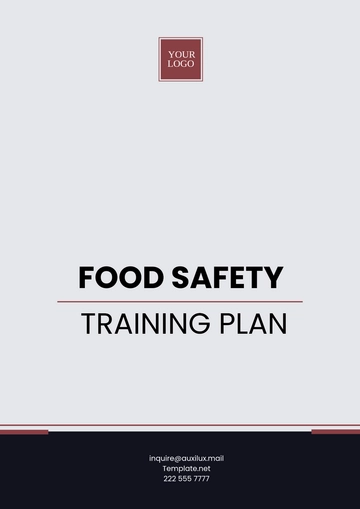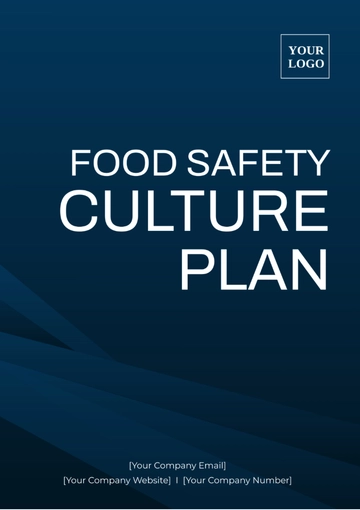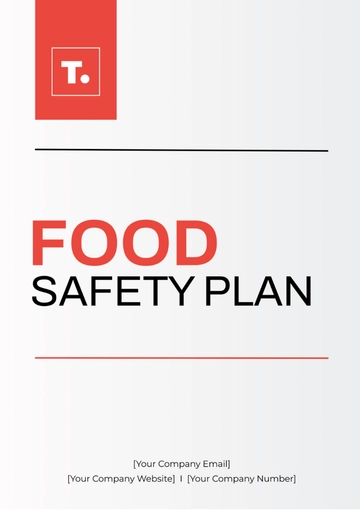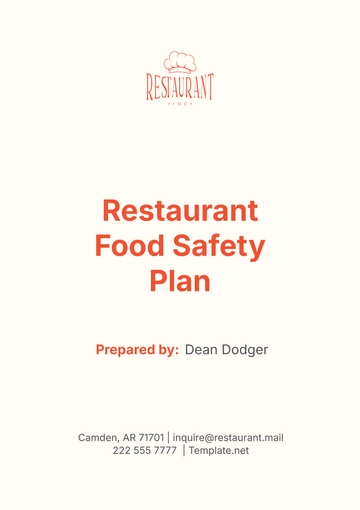Free Food Safety Culture Plan
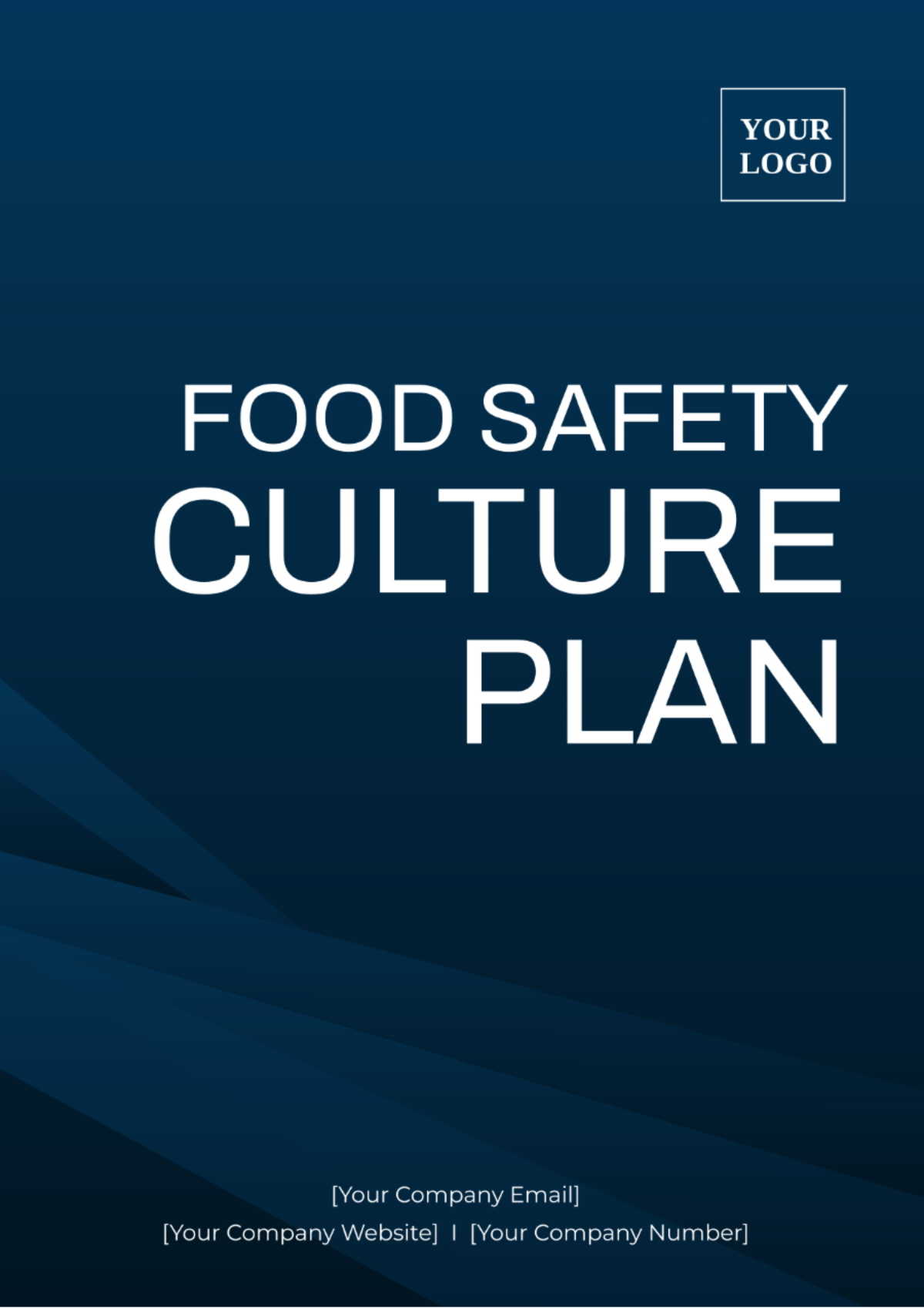
Written by: [Your Name]
_____________________________________________________________________________________
_____________________________________________________________________________________
I. Introduction
In today's fast-paced food industry, ensuring the safety of our products is paramount. The purpose of this Food Safety Culture Plan is to provide a comprehensive framework for [Your Company Name] to cultivate a culture where every individual involved in the production, handling, and distribution of food understands and prioritizes food safety. By fostering a robust food safety culture, we aim to mitigate risks, comply with regulations, and uphold the trust of our consumers.
_____________________________________________________________________________________
II. Leadership Commitment
Food safety starts at the top. Our leadership is committed to providing the necessary resources, support, and guidance to establish and maintain a strong food safety culture. This commitment is demonstrated through:
Regular communication of food safety expectations and goals.
Allocation of budget and resources for training and infrastructure improvements.
Inclusion of food safety performance metrics in key performance indicators (KPIs).
Participation in food safety committees and initiatives.
III. Employee Training and Engagement
A. Training Programs
We understand that knowledge is key to fostering a food safety culture. Therefore, we provide comprehensive training programs for all employees, tailored to their roles and responsibilities. These programs cover:
Basic food hygiene and safety principles.
Proper handling and storage of food.
Hazard analysis and critical control points (HACCP) principles.
Emergency response procedures in case of food safety incidents.
B. Employee Engagement
Engaged employees are vital to the success of our food safety culture. To foster engagement, we:
Encourage open communication channels for reporting concerns and suggestions.
Recognize and reward employees who demonstrate exemplary food safety practices.
Provide opportunities for continuous learning and skill development in food safety.
IV. Supplier Relationships
We recognize that the safety of our products relies not only on our internal practices but also on the quality and safety of ingredients and materials sourced from suppliers. Therefore, we:
Establish clear criteria for evaluating and selecting suppliers based on their food safety standards and practices.
Conduct regular audits and assessments of supplier facilities to ensure compliance with our standards.
Collaborate with suppliers to address any identified food safety issues and implement corrective actions.
V. Continuous Improvement
A. Regular Assessments
Continuous improvement is ingrained in our culture. We conduct regular assessments of our food safety practices and performance through:
Internal audits conducted by trained food safety professionals.
External audits by third-party certification bodies.
Employee feedback surveys to gauge perceptions and identify areas for improvement.
B. Corrective Actions
When deviations or deficiencies are identified, we take prompt corrective actions to address them. This includes:
Root cause analysis to determine the underlying causes of food safety incidents or non-conformances.
Implementation of corrective and preventive actions (CAPAs) to prevent recurrence.
Monitoring and verification of the effectiveness of implemented actions.
VI. Communication and Transparency
Transparent communication is essential for building trust with our consumers and stakeholders. Therefore, we:
Provide clear and accurate information about our food safety practices, policies, and procedures to consumers through packaging labels, website, and other communication channels.
Proactively communicate with regulatory agencies and public health authorities in the event of food safety incidents or recalls.
Encourage feedback from consumers and stakeholders to continuously improve our food safety practices.
VII. Review and Update
To ensure the effectiveness and relevance of this Food Safety Culture Plan, it will be regularly reviewed and updated as needed. The review process will include:
Evaluation of the implementation of food safety initiatives and programs.
Assessment of changes in regulations and industry best practices.
Feedback from employees, consumers, and stakeholders.
Incorporation of lessons learned from food safety incidents or near-misses.
_____________________________________________________________________________________
- 100% Customizable, free editor
- Access 1 Million+ Templates, photo’s & graphics
- Download or share as a template
- Click and replace photos, graphics, text, backgrounds
- Resize, crop, AI write & more
- Access advanced editor
Introducing our Food Safety Culture Plan Template, exclusively on Template.net. Crafted by experts, it's an editable and customizable solution to fortify your food safety protocols. Tailor it effortlessly to your needs using our AI Tool. Elevate your standards and ensure compliance seamlessly with this indispensable resource.
You may also like
- Finance Plan
- Construction Plan
- Sales Plan
- Development Plan
- Career Plan
- Budget Plan
- HR Plan
- Education Plan
- Transition Plan
- Work Plan
- Training Plan
- Communication Plan
- Operation Plan
- Health And Safety Plan
- Strategy Plan
- Professional Development Plan
- Advertising Plan
- Risk Management Plan
- Restaurant Plan
- School Plan
- Nursing Home Patient Care Plan
- Nursing Care Plan
- Plan Event
- Startup Plan
- Social Media Plan
- Staffing Plan
- Annual Plan
- Content Plan
- Payment Plan
- Implementation Plan
- Hotel Plan
- Workout Plan
- Accounting Plan
- Campaign Plan
- Essay Plan
- 30 60 90 Day Plan
- Research Plan
- Recruitment Plan
- 90 Day Plan
- Quarterly Plan
- Emergency Plan
- 5 Year Plan
- Gym Plan
- Personal Plan
- IT and Software Plan
- Treatment Plan
- Real Estate Plan
- Law Firm Plan
- Healthcare Plan
- Improvement Plan
- Media Plan
- 5 Year Business Plan
- Learning Plan
- Marketing Campaign Plan
- Travel Agency Plan
- Cleaning Services Plan
- Interior Design Plan
- Performance Plan
- PR Plan
- Birth Plan
- Life Plan
- SEO Plan
- Disaster Recovery Plan
- Continuity Plan
- Launch Plan
- Legal Plan
- Behavior Plan
- Performance Improvement Plan
- Salon Plan
- Security Plan
- Security Management Plan
- Employee Development Plan
- Quality Plan
- Service Improvement Plan
- Growth Plan
- Incident Response Plan
- Basketball Plan
- Emergency Action Plan
- Product Launch Plan
- Spa Plan
- Employee Training Plan
- Data Analysis Plan
- Employee Action Plan
- Territory Plan
- Audit Plan
- Classroom Plan
- Activity Plan
- Parenting Plan
- Care Plan
- Project Execution Plan
- Exercise Plan
- Internship Plan
- Software Development Plan
- Continuous Improvement Plan
- Leave Plan
- 90 Day Sales Plan
- Advertising Agency Plan
- Employee Transition Plan
- Smart Action Plan
- Workplace Safety Plan
- Behavior Change Plan
- Contingency Plan
- Continuity of Operations Plan
- Health Plan
- Quality Control Plan
- Self Plan
- Sports Development Plan
- Change Management Plan
- Ecommerce Plan
- Personal Financial Plan
- Process Improvement Plan
- 30-60-90 Day Sales Plan
- Crisis Management Plan
- Engagement Plan
- Execution Plan
- Pandemic Plan
- Quality Assurance Plan
- Service Continuity Plan
- Agile Project Plan
- Fundraising Plan
- Job Transition Plan
- Asset Maintenance Plan
- Maintenance Plan
- Software Test Plan
- Staff Training and Development Plan
- 3 Year Plan
- Brand Activation Plan
- Release Plan
- Resource Plan
- Risk Mitigation Plan
- Teacher Plan
- 30 60 90 Day Plan for New Manager
- Food Safety Plan
- Food Truck Plan
- Hiring Plan
- Quality Management Plan
- Wellness Plan
- Behavior Intervention Plan
- Bonus Plan
- Investment Plan
- Maternity Leave Plan
- Pandemic Response Plan
- Succession Planning
- Coaching Plan
- Configuration Management Plan
- Remote Work Plan
- Self Care Plan
- Teaching Plan
- 100-Day Plan
- HACCP Plan
- Student Plan
- Sustainability Plan
- 30 60 90 Day Plan for Interview
- Access Plan
- Site Specific Safety Plan
